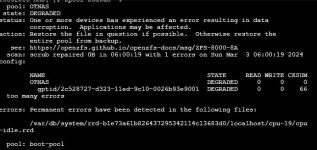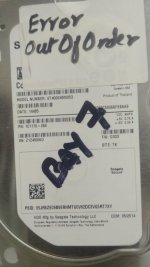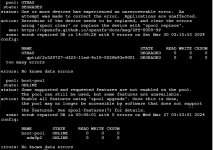- Joined
- May 28, 2011
- Messages
- 10,996
1) For the corrupt file, see this link:
 www.truenas.com
2) Once the corrupt file has been removed then run a scrub
www.truenas.com
2) Once the corrupt file has been removed then run a scrub
3) Once the scrub completes (6 hours and 20 minutes later), run
4) IF there were no new file errors and you only have the CKSUM errors, run
So back to the BIOS RAID5... If this pool is made from this RAID5 set of drives, I will have to say that it looks like you do have a real RAID setup as TrueNAS only sees one drive. Fixing this is easy, but not fast, nor cheap and does require you to copy your data to another system.
DEGRADED system db file
Hi, I have a DEGRADED data pool with only the df_complex-reserved.rrd file corrumped. I cannot delete ist, and do not know how to regenerate this file. root@truenas[~]# zpool status -x -v pool: volume1 state: DEGRADED status: One or more devices has experienced an error resulting in data...
zpool scrub OTNAS3) Once the scrub completes (6 hours and 20 minutes later), run
zpool status -v and see if you have any files with errors. If you do have errors, post a screen capture of that and wait for assistance.4) IF there were no new file errors and you only have the CKSUM errors, run
zpool clear OTNAS and then repeat the command in step 3. With any luck you will no longer have any errors.So back to the BIOS RAID5... If this pool is made from this RAID5 set of drives, I will have to say that it looks like you do have a real RAID setup as TrueNAS only sees one drive. Fixing this is easy, but not fast, nor cheap and does require you to copy your data to another system.



